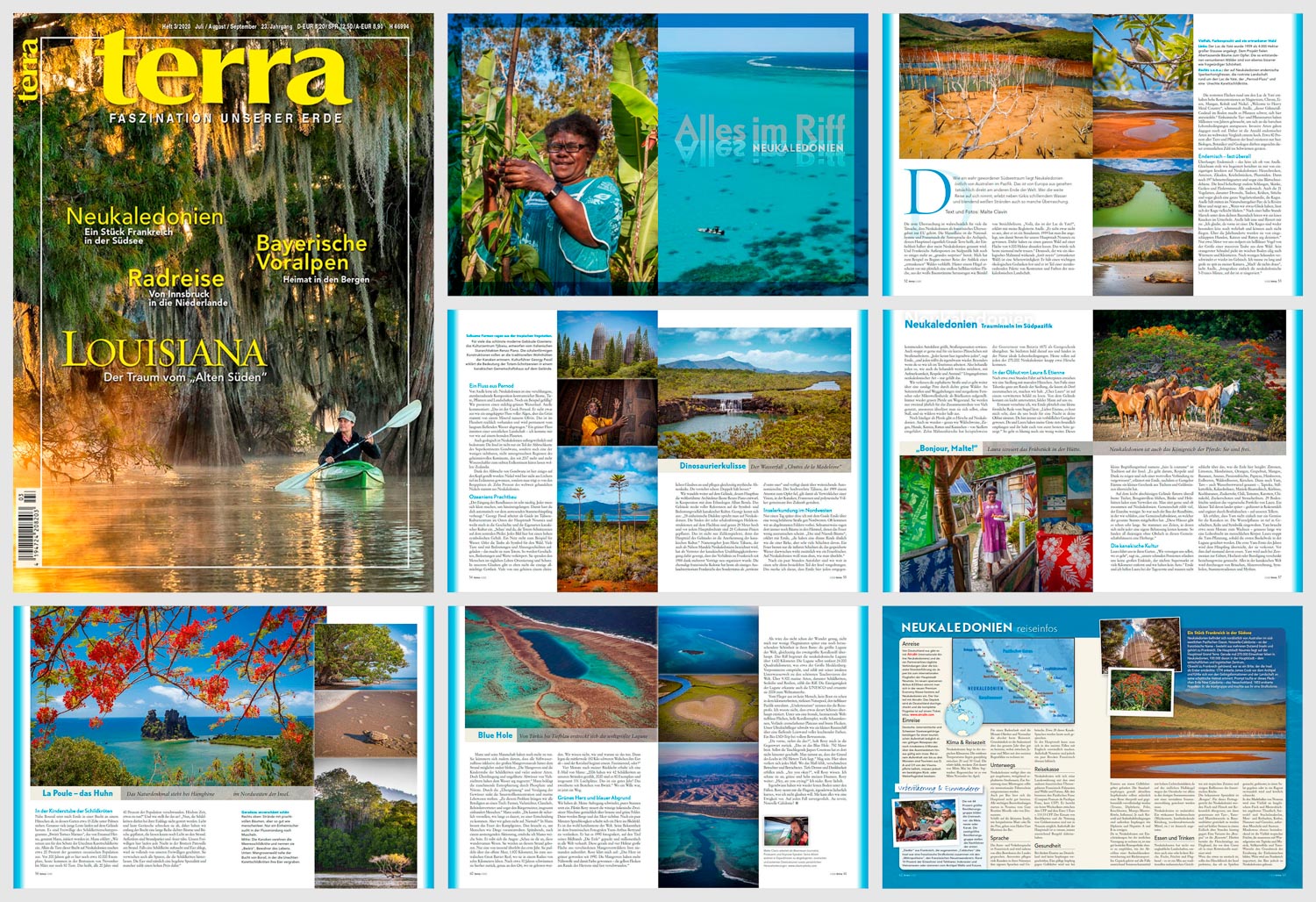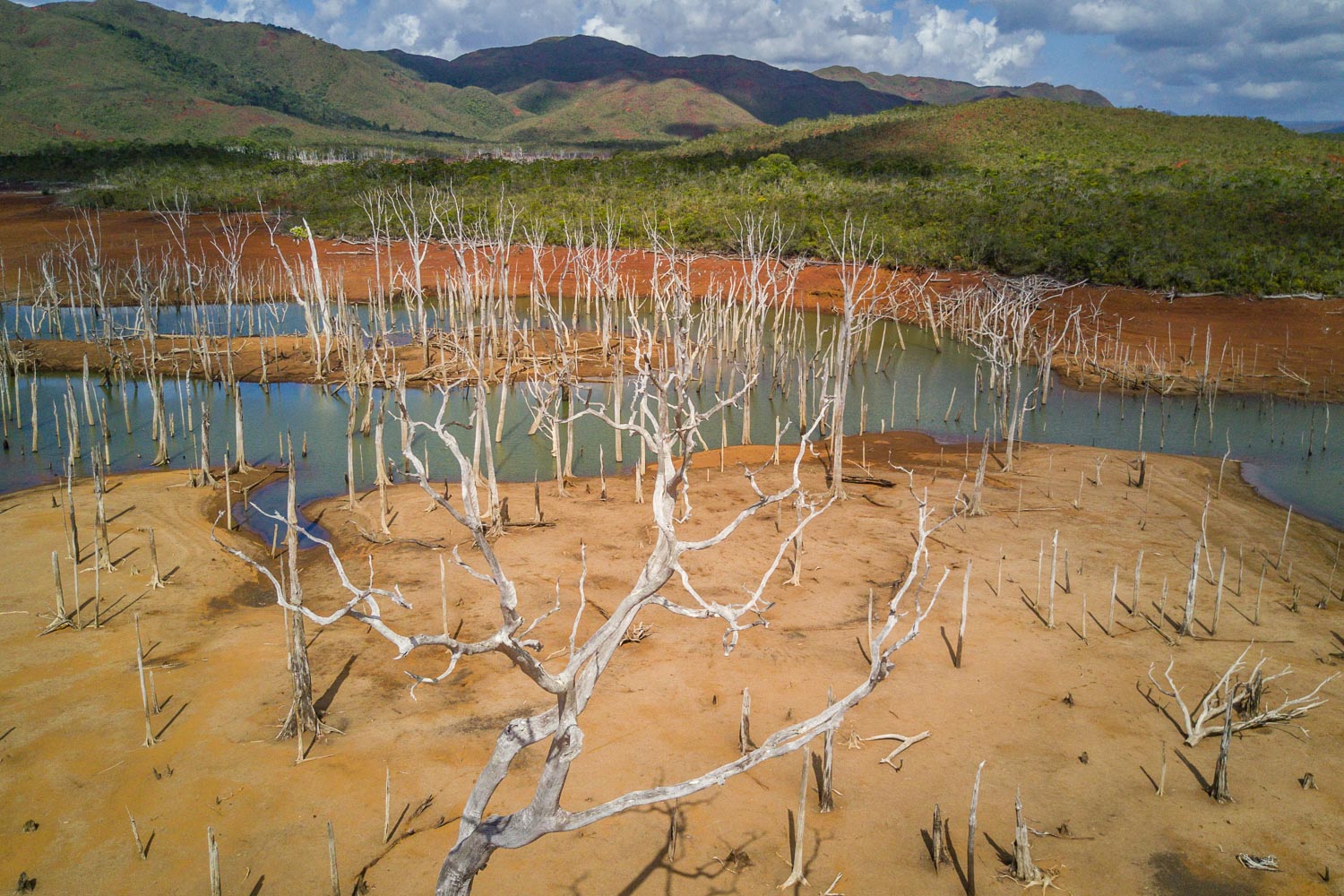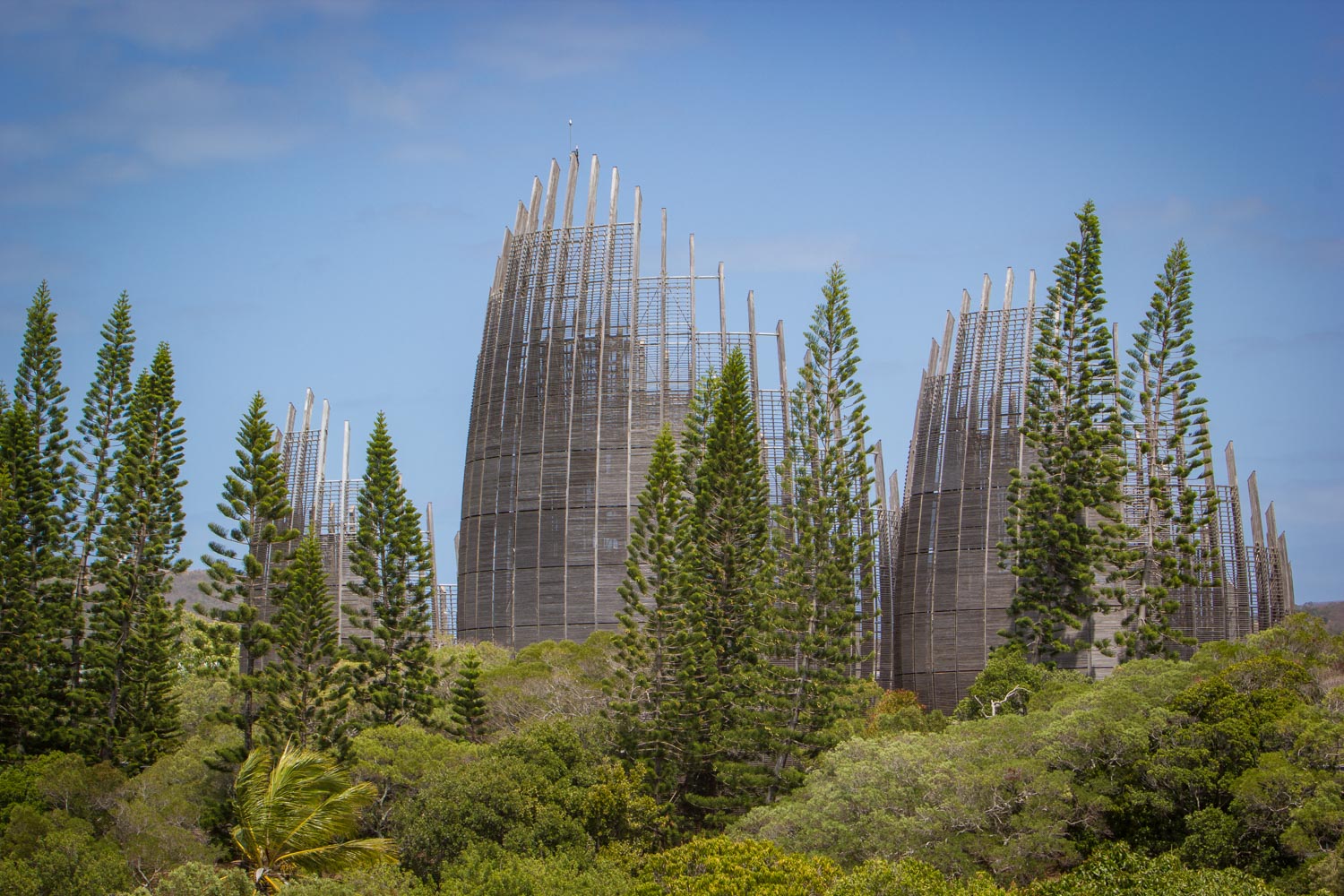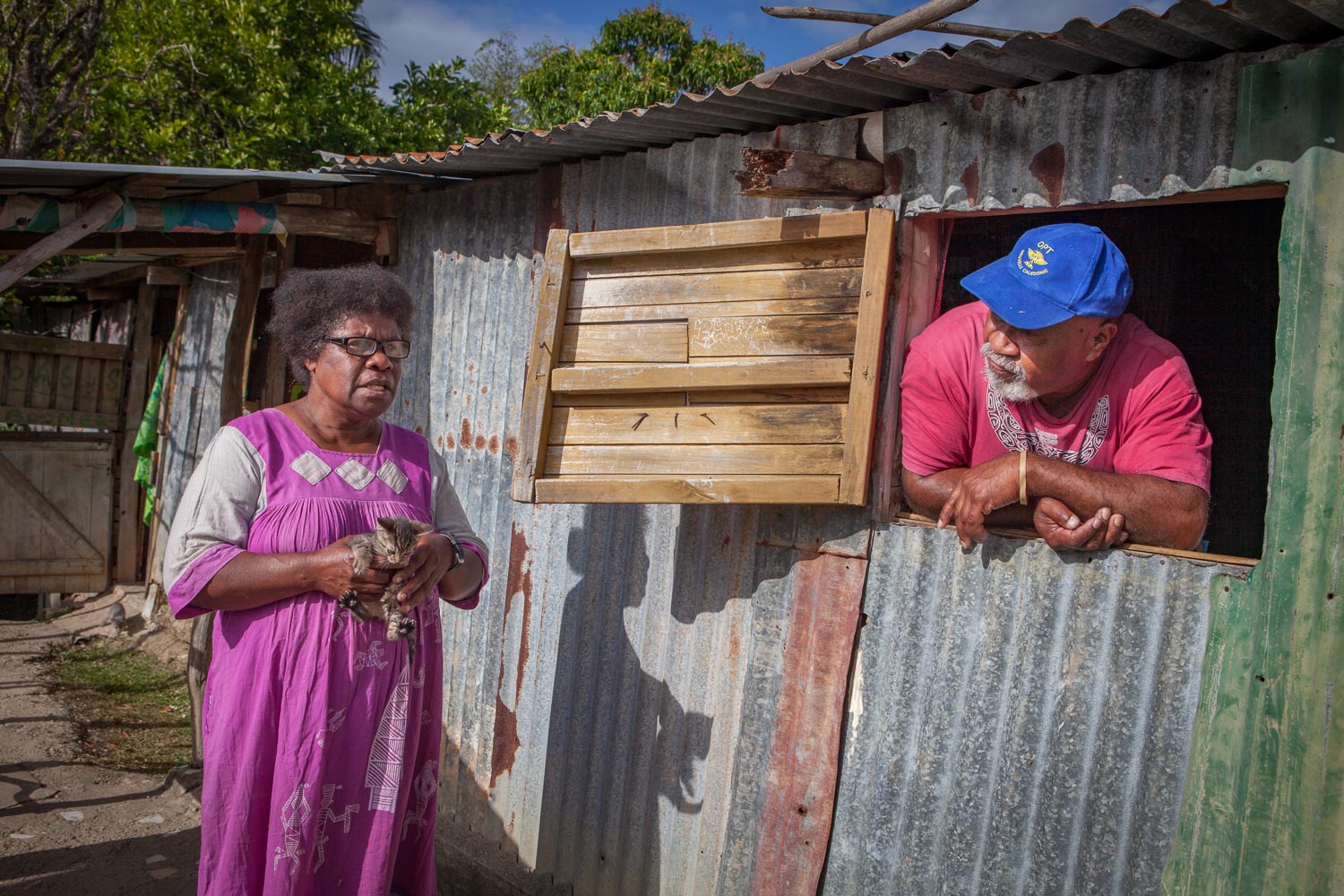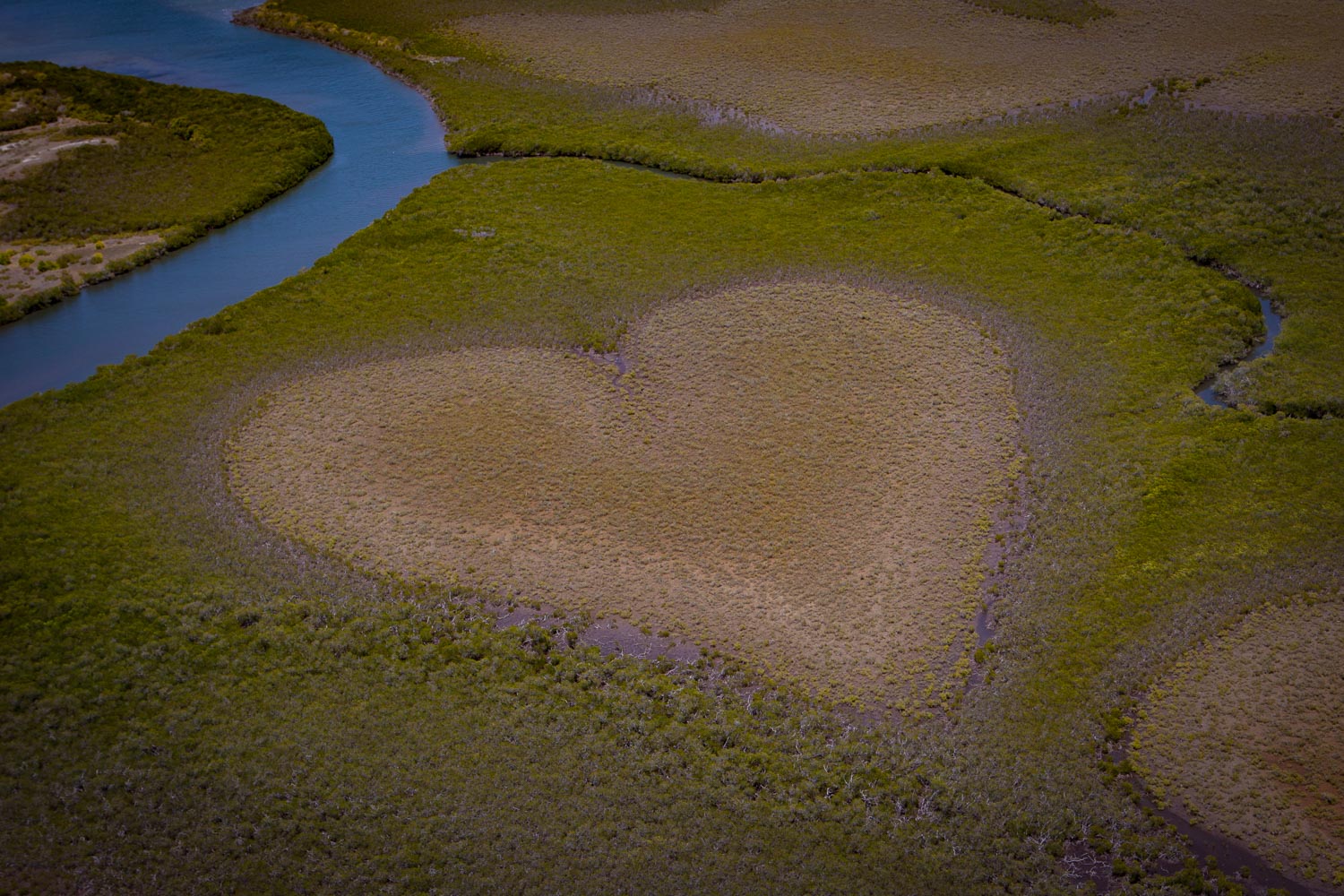Published in:

Germany’s biggest nature travel magazine
14 pages | text & photography
South Sea with sunken forest and mangrove heart
And then finally over the hill, an endless light blue-turquoise expanse suddenly opens up in front of me, with white tree trunks sticking out of it like bundles of matchsticks. “Voilà. That’s Lac de Yaté,” my companion Axelle explains to me, “it may not look like it, but it’s a reservoir. The dam was built in 1959 to generate electricity for our capital, Nouméa. They flooded an entire forest covering an area of 4,000 hectares.
These days no one would dare do such a thing anymore”. Nevertheless, the forêt noyée (the drowned forest), as an ecological memento is a sight to behold: it captures an important ecological idea and it is part of a breathtaking palette of contrasts and colours of the New Caledonian landscape.
Rusty red areas around Lac de Yaté contain high concentrations of magnesium, chromium, iron, manganese, cobalt and nickel. “Welcome to Heavy Metal Land”, Axelle smiles, “this toxic metal cocktail in the soil makes it difficult for plants to settle here.”
Native animal and plant species have taken millions of years to adapt to the harsh living conditions. Invasive species, on the other hand, gave up quickly. Therefore, the number of endemic species is extremely high here compared to the rest of the world. About 80 % of all animal and plant species on the island exist only here. It inspires enthusiasm in biologists, botanists and geologists.
„This toxic metal cocktail in the soil makes it difficult for plants to settle here.“
Endemic almost everywhere
I often hear ‘endemic’ from Axelle. As proud as she is enthusiastic, she tells me about the unique insects on New Caledonia: Grasshoppers, ants, cicadas, black flies, phasmids. Then there are 197 species of butterflies and even a leaf-cutting bee.
The island is also home to snakes, skinks, geckos and bats. All endemic. There are also 21 species of birds, including thrushes, pigeons, crows, parakeets and even an entire family of birds, the kagus. Axelle stops in the middle of the shady ‘Park de la Rivière Bleue’ and gets out. “If we’re lucky, we might see the kagu.”
After half an hour of walking underneath the dense canopy, we hear a soft crackling noise in the undergrowth. Axelle pauses and whispers, “I think there’s one ahead. The kagus are neither particularly quiet, nor defensive, nor can they fly. For centuries they have been decimated by introduced dogs, cats and rats.”
Just two metres in front of us, a light blue bird the size of a massive pigeon stumbles out of the forest. Its orange-red beak restlessly pecks into the soft soil for worms and small animals. A few seconds later it disappears into the undergrowth. It catches me by surprise and when I reach for my camera it is too late. “Don’t worry about it,” Axelle laughs, “just take a picture of the New Caledonian 5-franc coin, it’s engraved on it.”
The Lac de Yaté was created in 1959 as a 4000 hectare reservoir. Thousands of trees fell victim to the project and the resulting sunken forests are a bizarre and questionable beauty.
A river of Pernod
Axelle enlightens me: New Caledonia is an intricate, breathtaking assembly of contrasting biomes, animals, plants and landscapes. Want another example? We pass a milky green watercourse. Axelle remarks: “This is the ‘Creek Pernod’. It looks like a river gone bad full of algae, but the green comes from a mineral called olivine. This is abundantly present in the riverbed and is constantly eroded by the slow-moving water.” A green river in the middle of a primeval landscape – I feel like I’m on an alien planet.
New Caledonia is also notably exceptional from a geological point of view: the island is not only part of the break-off edge of the supercontinent Gondwana, but also one of the few visible, non-submerged regions of the mysterious continent which, since 2017, more and more scientists would want to have designated the seventh continent on Earth: Zealandia.
Due to the break-up of Gondwana, things have been turned upside down here: nickel is not extracted from holes deep within the earth’s interior here, but it is carried off the mountain tops. 10 % of the nickel traded worldwide originates from New Caledonia.
“28 dialects are spoken on New Caledonia.”
Oceania’s magnificent building
“The entrance to the roundhouse is very low. Everyone has to bend to get in. Doing that, you automatically bow to the tribal chief in attendance.” Georgy Passil works as a guide at the Tjibaou Cultural Centre and initiates me into the history and mysteries of Kanak culture. “Look there, the totem carvings on the central pillar.
Every image here has a deep symbolic content. A net, for example, stands for water. Or the dove as a symbol for the forest. Many animals are charged with meanings and ancestral stories – this makes them a totem. This is how stories, meanings and values are embodied. They give people context and protection in their daily lives. In our believe system, there is not just one omnipotent deity. Many of us belong to a Christian faith and at the same time follow mythical ancestor cults. You get the picture: two is better than one.”
We continue to walk the grounds, the main building was designed by the world-famous architectural icon Renzo Piano in cooperation with the ethnologist Alban Benda. It is full of references to the wide array of symbols and meanings of Kanak culture. Georgy knows his stuff: “28 dialects are spoken on New Caledonia.
The pillars of the egg-shaped buildings are exactly 28 metres high, 28 Columné pines are planted in front of each main section and we observe everything with 28 surveillance cameras. Besides the numbers game, one must not forget that the main purpose of the building was the acknowledgement of the Kanak culture. “Named after Jean-Marie Tjibaou, who is also called the Nelson Mandela of New Caledonia, the representative of the Kanak independence movement has ensured that the relationship with France has been reframed since 1988 thanks to several treaties.
The former colony is France’s only foreign territory to have the special status of ‘Pays d’outre-mer’ and thus has far-reaching political autonomy. The highly revered Tjibaou, who was assassinated in 1989, is thus regarded as the one who materialised the vision in which Kanaks, French and Polynesian people shape their future together.
For many, the most beautiful new building in Ozenia: the Tjibaou Cultural Centre, designed by Italian star architect Renzo Piano.
Exploring the islands in the northwest
Only one day later, I am driving with Emile along a little-used highway direction north-west. We often pass burnt fields. Strangely enough, there are still trees sticking out which seem to be unaffected by the fire. “These are niaouli trees,” Emile explains to me, “they have a thin bark similar to that of a birch, but many layers of it. A fire only burns the outer layers, the stored water in between also acts like a fire extinguisher. On New Caledonia you know how to survive.”
After a few hours drive we have advanced far into a sparsely populated part of the island. I notice that Emile greets every oncoming motorist here, pedestrians anyway.
He also likes to stop for a quick chat with road workers. “Everybody knows everybody here,” says Emile, “and you’ll meet everyone again at some point. Especially if you work in tourism like me. So treat everyone the way you want to be treated, with attention, respect and decency.” New Caledonian manners, I like that.
“Everybody knows everybody here and you’ll meet everyone again at some point.”
We leave the surfaced road and continue on a sandy track through dense green forests. Disused television sets or microwave ovens are set up as letterboxes on side roads and at junctions. Again and again you see horses graze along the side of the road. They are only used twice a year for rounding up cattle, otherwise they roam around and are left to fend for themselves, without stables, they sort of re-wild again.
Even more than horses, there are deer on New Caledonia. They too were introduced – as were wild boars, goats, dogs, cats, rats and rabbits. Ten maned deer were presented as a gift by the governor of Batavia in 1870. They soon escaped and found ideal living conditions in the wild. Today, there are said to be just under two deer for every 270,000 New Caledonians.
In the care of Laura & Etienne
After about a two hours drive on gravel roads, we reach a settlement with shattered little houses. At the foot of a valley basin on the very edge of the settlement, which is hardly recognisable as a village, we stop. ‘Chez Laura’ can be made out on a weathered sign. A slightly stocky, jovial man steps out of the compound towards us.
Then Emile suddenly launches into a short formal speech: ” Dear Etienne, I am very pleased that you are taking us both into your care for the night. You have always been an exemplary host. You and Laura have always received my guests graciously and you have been on your best behaviour.”
And so it goes on in flowery language for about a minute. This little welcoming ritual called ‘faire la coutume’ is a tradition on the island. “It’s about showing respect and gratitude and making sure you have a valuable connection,” Emile explains to me after he has presented host Etienne with a small gift of cloths and coins.
Laura and Etienne Boya Wayahat offer their guests in the sparsely populated northwest of New Caledonia an experience of Kanak culture, cuisine and hospitality.
On the slightly sloping terrain, colourful cloths flutter everywhere, bougainvilleas bloom, benches and wooden huts invite you to linger. People like to sit together often on New Caledonia. Community counts a lot, the individual less so. The construction of the roundhut in which we sleep was also a community effort, in which the entire tribe participated.
“These houses have been around for a very long time. They date back to times when not everyone could afford their own dwelling. So all those without shelter found a place to stay in these community houses.”
The Kanak Matrix
Laura takes us into her garden. “We provide for ourselves if we can,” she says, “our small pensions don’t allow us to do much shopping, the nearest supermarket is many kilometres away and we don’t have a car.” Emile and I help Laura with the day’s harvest and are amazed at what the soil all has to offer: lemons, limes, mandarins, oranges, grapefruit, mangoes, bananas, pineapples, passion fruit, papaya, raspberries, strawberries, wild strawberries, cherries.
Then there is yam, taro, tapioca, sweet potato, cocoa beans, cassava bisamei, pumpkins, plantains, sugar cane, chili, tomatoes, carrots, Chinese cabbage, sugar snap peas and pigeon peas. Laura’s vegetarian portfolio contains 29 different crops. A small part of it ends up on our plates later – steamed in coconut milk and complemented by roast chicken.
Yam takes about nine months to grow – the same amount of time as a foetus in the human body.
I discover that yam is not just a vegetable for the Kanaks. The root plant is deeply woven into stories, cults and symbolism. Yam takes about nine months to grow – the same amount of time as a foetus in the human body. Laura stops planting yam as soon as the first humpback whales are spotted in the lagoon. The first yam harvest of the year is presented to the chief, who samples it. No one is allowed to eat it before him.
Yam is also presented or exchanged at ceremonies, like births, weddings or funerals. Everything in the Kanak world is held together by a matrix of customs, ancestors, symbols, meanings and myths.
In the nursery of the turtles
Near Bourail, Emile drops me off in a bay at a little house with about 15 tents spread out in the garden under palm trees. There are just as many young people running around on the grounds. They are volunteers of the turtle conservation programme Bwärä, initiated by Emanuel Hernu, called Manu.
Manu explains: “We work to protect the loggerhead turtle (Careta careta). The animals of this bay alone make up about 20 % of the entire oceanic population. 200 years ago, there were still about 10,000 specimens here, but today only 50 animals arrive in the breeding season from November to March. That means that every 20 years, 40 % of the population has disappeared. It’s imperative that we do something about it.” And what do you do? “Well, the turtles must not be disturbed when they are laying their eggs. Light and noise scares them off, so we have planted a long row of dense trees and bushes along the bay, which hardly let any light shine through onto the beach.
In addition, beach parties and bonfires are strictly prohibited. Our volunteers here patrol the beach every night during the breeding season. If a turtle shows up and lays eggs, it is fully protected by our volunteers. They also cover all traces left by the turtles. After all, the eggs are a coveted speciality and some people pay a high price for them.”
Manu and his crew have even more to do. They also make sure that all freshwater tributaries, including the large mangrove area behind the beach, remain as clean as possible. “The mangroves are the nursery of the turtles and many other species. But over-fertilisation and unfiltered sewage from cattle farmers have taken a toll on the water.”
Manu laments the increasing eutrophication caused by phosphates and nitrates, this ‘over-greening’ and algalisation of the waters robs vital oxygen for marine life. “Here we bring all the lobbyists and donors to the table: farmers, livestock breeders, clan chiefs, government officials and even the mayor, one hundred people in all.” Manu sighs, “You can imagine how long it takes to reach a decision. But we’re not giving up. Ever.”
There is a permanent, slightly nervous tension in Manu: the fire of his fighting spirit. That’s what it takes to drive people and things. Late in the evening, after an exhausting day of action, I discover Manu’s soft side. He rubs his eyes: “Look at them, these wondrous beings.
They are born on this beach. Only one in a thousand survives the first year. They paddle across the open sea, 1,800 kilometres, to the Australian barrier reef, where they live within a radius of ten kilometres. After about 30 years, they swim back here, exactly to the place where they were born. We don’t know how and why they do it. Then the females, which then weigh a 150 kg, lay their eggs – and the cycle begins again. Fascinating, isn’t it?”
Everyone knows the landmark of New Caledonia: the world-famous heart of Voh, an extraordinary creation of nature, which formed here a unique and perfect heart in the green.
Four months after my return, I receive an email from Manu: “In 2006 we counted 42 turtles on our beaches, in 2020 there are 80 specimens and a total of 331 hatching sites. That’s a good year! The second best since Bwärä was established.” Where there was a will, there is now a way.
Green heart and blue abyss
We take off. My excitement fades, pure amazement sets in. Pilot Rosy lifts the tiny Italian two-seater plane leisurely over brown and green fields. Then mountains and the sea come into view. After a few minutes of speechlessness, a heart appears.
It is probably the most famous in the world. It owes its fame to the French photographer Yann-Arthus Bertrand. He photographed it in 1990, put it on the cover of his illustrated book THE EARTH and sold millions of copies all over the world. This area of just four hectares of various mangrove forests leaves no one untouched. Rosy enlightens me: “The heart has become greener since 1990. The mangroves have gained more nutrients and thus colour – the yellow spots at the edge of the heart have almost disappeared.”
As if that wasn’t rewarding enough, an even more intoxicating beauty was to assail me just a few minutes into the flight: The largest lagoon in the world, also the second largest coral reef anywhere. The reef borders the New Caledonian lagoon for over 1,600 kilometres. The lagoon itself covers 24,000 km2, which is roughly the size of Mecklenburg-Vorpommern, and its intact underwater world makes it one of the most beautiful diving areas in the world. Over 9300 marine species, including turtles, manatees, rays and quite a number of species of fish can be found on the reef. The uniqueness of the lagoon was also recognised by UNESCO, which designated it a World Heritage Site in 2008.
Up here, all sense of dimension is lost.
From the plane not a single person or boat can be spotted in the kilometre-wide, iridescent turquoise natural pool framed by the deep blue of the Pacific. Travel professionals call this ‘under-tourism’. I didn’t know something so beautiful could exist. Below us, a strange, fascinating world: deep blue surfaces, bright bits of coral, whitecaps, gradients of cream-coloured plateaus and colourful spots.
Our ultra-light aircraft sways like a small spaceship over a flowing canvas full of luminescent colours. A bio-LSD trip in full consciousness.
“Over there, see that?” Rosy brings me back into the present. “That’s the Blue Hole. 750 metres wide. Our diving legend Jaques Cousteau never made it down there. It is thought that the bottom of the hole is at 150 metres. ” Perhaps. Up here, all sense of dimension is lost. Where the dimensions are missing, the observer and the observed merge. Deep humility and gratitude overwhelm me.
“Are you ok?” Rosy wants to know. I look at her, grin and raise my thumb. Rosy continues, “Hey, are you weeping?” I nod. Rosy smiles.
Eventually we get our feet back onto solid ground. Rosy informs me of the flight duration, so ridiculously short that I don’t want to believe her. It all seemed like an eternity to me. Either way, unforgettable.
Au revoir, Nouvelle Calédonie!
Read now:
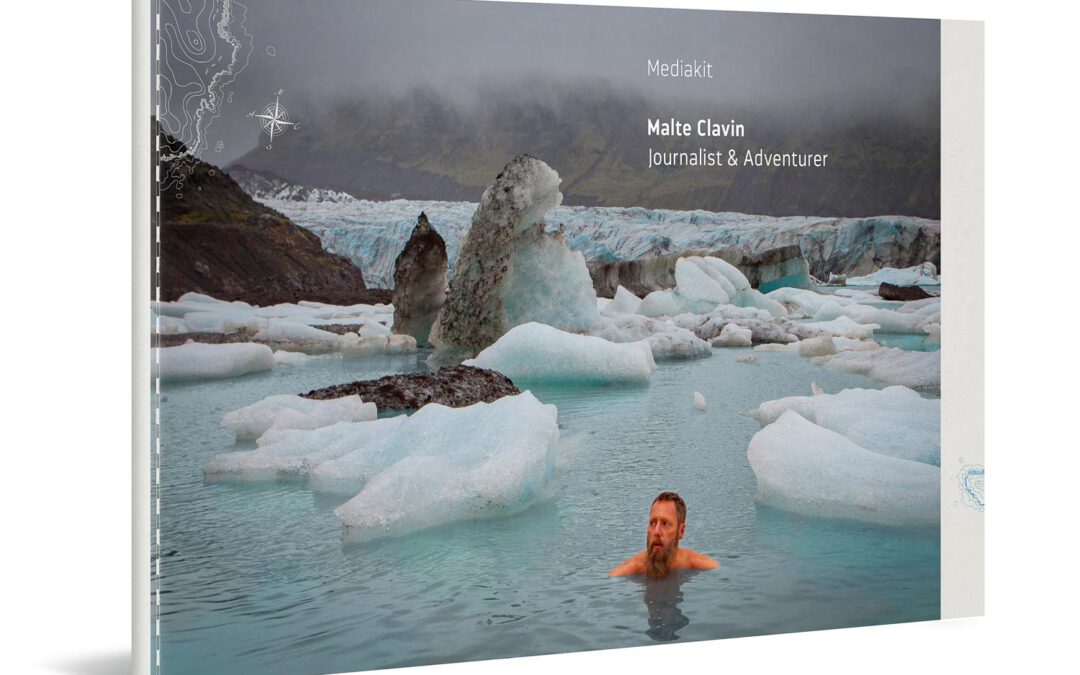
Pure inspiration
My new media kit 2025
< 1 Min.In this brand new 28-page media kit, I show you my work as an adventure journalist and speaker: Expeditions, travels, challenges – everything that excites me. Let yourself be inspired.
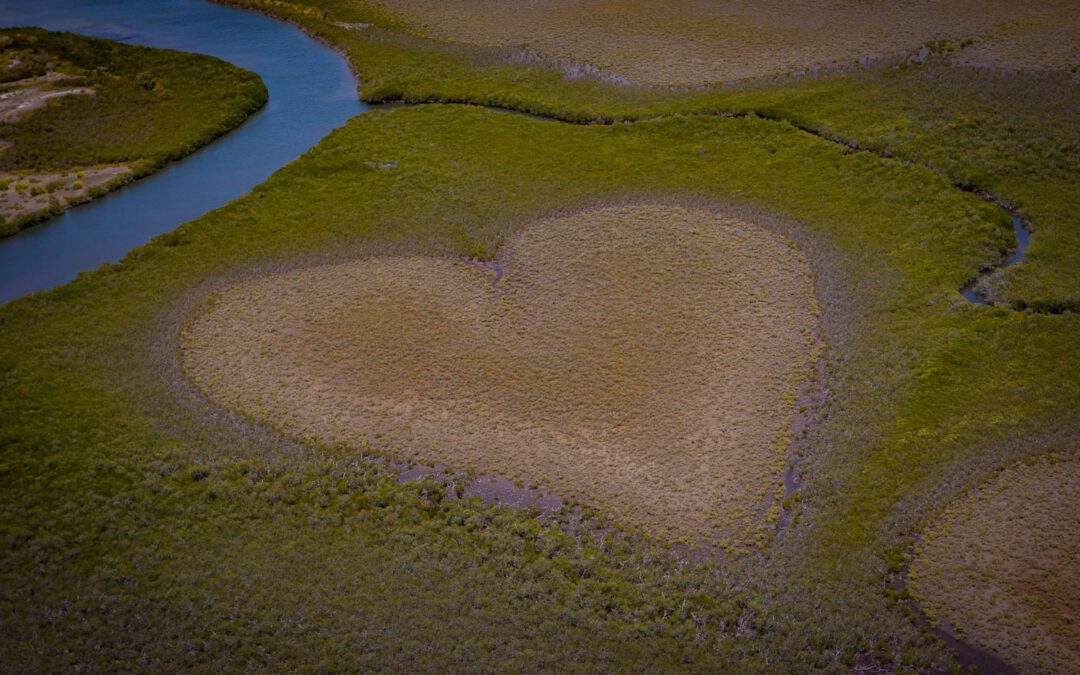
All endemic or what?
New Caledonia photo gallery
< 1 Min.Grasshoppers, ants, cicadas, black flies, phasmids. Then 197 species of butterflies and even a leafcutter bee. The island is also home to endemic snakes, skinks, geckos, bats, 21 species of birds, including an entire family of bird species, the kagus.
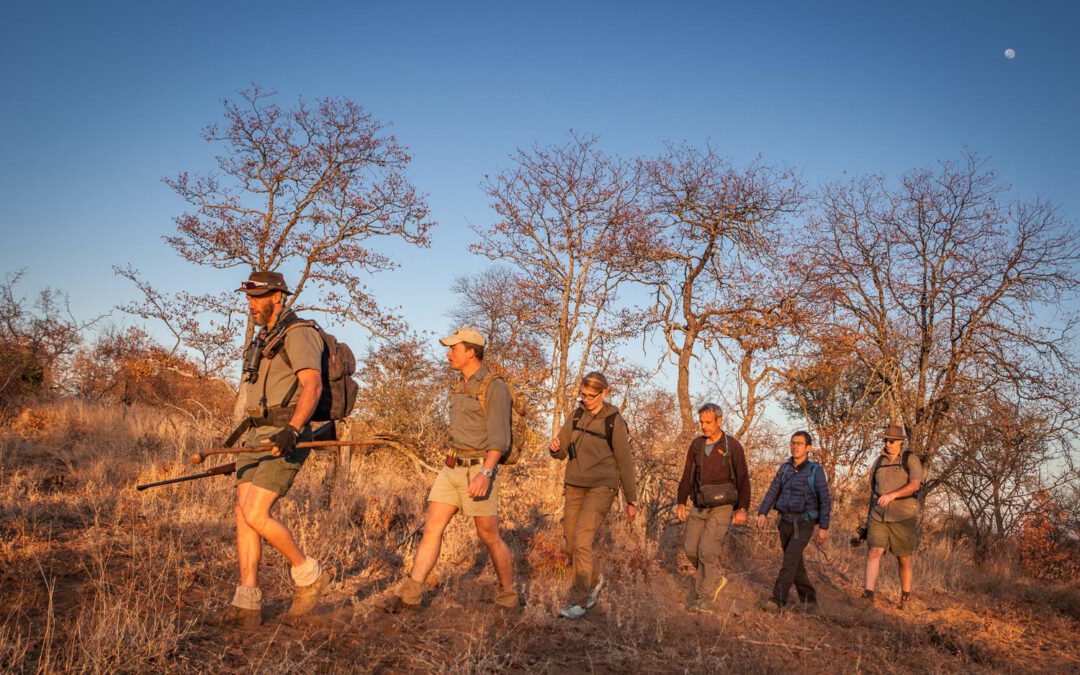
Ranger Training in South Africa
Something is up in the bush
16 Min.Exploring the wilderness on foot in the midst of lions, elephants and buffalo? You can learn to do that. In summer 2019, I will join a field guide course in South Africa.

